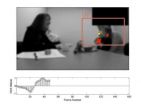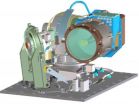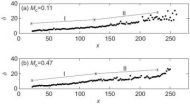(Press-News.org) DURHAM, N.C. -- Most schools across the United States provide simple vision tests to their students--not to prescribe glasses, but to identify potential problems and recommend a trip to the optometrist. Researchers are now on the cusp of providing the same kind of service for autism.
Researchers at Duke University have developed software that tracks and records infants' activity during videotaped autism screening tests. Their results show that the program is as good at spotting behavioral markers of autism as experts giving the test themselves, and better than non-expert medical clinicians and students in training.
The results appear online in the journal Autism Research and Treatment.
"We're not trying to replace the experts," said Jordan Hashemi, a graduate student in computer and electrical engineering at Duke. "We're trying to transfer the knowledge of the relatively few autism experts available into classrooms and homes across the country. We want to give people tools they don't currently have, because research has shown that early intervention can greatly impact the severity of the symptoms common in autism spectrum disorders."
The study focused on three behavioral tests that can help identify autism in very young children.
In one test, an infant's attention is drawn to a toy being shaken on the left side and then redirected to a toy being shaken on the right side. Clinicians count how long it takes for the child's attention to shift in response to the changing stimulus. The second test passes a toy across the infant's field of view and looks for any delay in the child tracking its motion. In the last test, a clinician rolls a ball to a child and looks for eye contact afterward -- a sign of the child's engagement with their play partner.
In all of the tests, the person administering them isn't just controlling the stimulus, he or she is also counting how long it takes for the child to react -- an imprecise science at best. The new program allows testers to forget about taking measurements while also providing more accuracy, recording reaction times down to tenths of a second.
"The great benefit of the video and software is for general practitioners who do not have the trained eye to look for subtle early warning signs of autism," said Amy Esler, an assistant professor of pediatrics and autism researcher at the University of Minnesota, who participated in some of the trials highlighted in the paper.
"The software has the potential to automatically analyze a child's eye gaze, walking patterns or motor behaviors for signs that are distinct from typical development," Esler said. "These signs would signal to doctors that they need to refer a family to a specialist for a more detailed evaluation."
According to Hashemi and his adviser, Guillermo Sapiro, professor of electrical and computer engineering at Duke, because the program is non-invasive, it could be useful immediately in homes and clinics. Neither, however, expects it to become widely used -- not because clinicians, teachers and parents aren't willing, but because the researchers are working on an even more practical solution.
Later this year, the Duke team (which includes students and faculty from engineering and psychiatry) plans to test a new tablet application that could do away with the need for a person to administer any tests at all. The program would watch for physical and facial responses to visual cues played on the screen, analyze the data and automatically report any potential red flags. Any parent, teacher or clinician would simply need to download the app and sit their child down in front of it for a few minutes.
The efforts are part of the Information Initiative at Duke, which connects researchers from disparate fields to experts in computer programming to help analyze large data sets.
"We're currently working with autism experts at Duke Medicine to determine what sorts of easy tests could be used on just a computer or tablet screen to spot any potential concerns," said Sapiro. "The goal is to mimic the same sorts of social interactions that the tests with the toys and balls measure, but without the toys and balls. The research has shown that the earlier autism can be spotted, the more beneficial intervention can be. And we want to provide everyone in the world with the ability to spot those signs as early as possible."
INFORMATION:
This research was supported by the National Science Foundation (1039741, 1028076), CAPES (BEX 1018/11-6), and FAPESP (2011/01434-9) Ph.D. scholarships from Brazil and the U.S. Department of Defense. Also supporting the research is the Office of Naval Research, the National Geospatial-Intelligence Agency, the Army Research Office, and the Air Force Office of Scientific Research.
"Computer vision tools for low-cost and non-invasive measurement of autism-related behaviors in infants," Hashemi, J.; Tepper, M.; Spina, T.V.; Esler, A.; Morellas, V.; Papanikolopoulos, N.; Egger, H.; Dawson, G.; Sapiro, G. Autism Research and Treatment, 2014.
Screening for autism: There's an app for that
Automated video analysis to identify children on the autism spectrum earlier
2014-05-22
ELSE PRESS RELEASES FROM THIS DATE:
How the gut feeling shapes fear
2014-05-22
An unlit, deserted car park at night, footsteps in the gloom. The heart beats faster and the stomach ties itself in knots. We often feel threatening situations in our stomachs. While the brain has long been viewed as the centre of all emotions, researchers are increasingly trying to get to the bottom of this proverbial gut instinct.
It is not only the brain that controls processes in our abdominal cavity; our stomach also sends signals back to the brain. At the heart of this dialogue between the brain and abdomen is the vagus nerve, which transmits signals in both directions ...
Radiofrequency ablation and complete endoscopic resection equally effective for dysplastic Barrett's esophagus
2014-05-22
DOWNERS GROVE, Ill. – May 21, 2014 – According to a new systematic review article, radiofrequency ablation and complete endoscopic resection are equally effective in the short-term treatment of dysplastic Barrett's esophagus, but adverse event rates are higher with complete endoscopic resection. The article comparing the two treatments appears in the May issue of GIE: Gastrointestinal Endoscopy, the monthly peer-reviewed scientific journal of the American Society for Gastrointestinal Endoscopy (ASGE).
Barrett's esophagus is a condition in which the lining of the esophagus ...
Molecule acts as umpire to make tough life-or-death calls
2014-05-22
(MEMPHIS, Tenn. – May 20, 2014) Researchers have demonstrated that an enzyme required for animal survival after birth functions like an umpire, making the tough calls required for a balanced response to signals that determine if cells live or die. St. Jude Children's Research Hospital scientists led the study, which was published online and appears in the May 22 edition of the scientific journal Cell.
The work involved the enzyme receptor-interacting protein kinase 1 (RIPK1). While RIPK1 is known to be involved in many vital cell processes, this study shows that its pivotal ...
Aggressive behavior observed after alcohol-related priming
2014-05-22
May 22, 2014-- Researchers from California State University, Long Beach, the University of Kent and the University of Missouri collaborated on a study to test whether briefly exposing participants to alcohol-related terms increases aggressive behavior. It has been well documented by previous research that the consumption of alcohol is directly linked to an increase in aggression and other behavioral extremes. But can simply seeing alcohol-related words have a similar effect on aggressive behavior?
Designing the experiment
The study, published in the journal Personality ...
First broadband wireless connection ... to the moon?!
2014-05-22
WASHINGTON, May 22, 2014—If future generations were to live and work on the moon or on a distant asteroid, they would probably want a broadband connection to communicate with home bases back on Earth. They may even want to watch their favorite Earth-based TV show. That may now be possible thanks to a team of researchers from the Massachusetts Institute of Technology's (MIT) Lincoln Laboratory who, working with NASA last fall, demonstrated for the first time that a data communication technology exists that can provide space dwellers with the connectivity we all enjoy here ...
On quantification of the growth of compressible mixing layer
2014-05-22
CML has been a research topic for more than five decades, due to its wide applications in propulsion design. Mixing in CML is controlled by the compressibility effects of velocity and density variations over the mixing layer, and quantified by the growth rate of CML. However, the lack of understanding of various definitions of mixing thicknesses has yielded scatter in analyzing experimental data. Prof. SHE ZhenSu and his colleagues at the State Key Laboratory for Turbulence and Complex Systems, Peking University investigated the growth of compressible mixing layer by introducing ...
Nanoshell-emitters hybrid nanoobject was proposed as promising 2-photon fluorescence probe
2014-05-22
Two-photon excitation fluorescence is growing in popularity in the bioimaging field but is limited by fluorophores' extremely low two-photon absorption cross-section. The researcher Dr. Guowei Lu and co-workers from State Key Laboratory for Mesoscopic Physics, Department of Physics, Peking University, are endeavoring to develop efficient fluorescent probes with improved two-photon fluorescence (TPF) performance. They theoretically present a promising bright probe using gold nanoshell to improve the TPF performances of fluorescent emitters. Their work, entitled "Plasmonic-Enhanced ...
Stanford research shows importance of European farmers adapting to climate change
2014-05-22
A new Stanford study finds that due to an average 3.5 degrees Fahrenheit of warming expected by 2040, yields of wheat and barley across Europe will drop more than 20 percent.
New Stanford research reveals that farmers in Europe will see crop yields affected as global temperatures rise, but that adaptation can help slow the decline for some crops.
For corn, the anticipated loss is roughly 10 percent, the research shows. Farmers of these crops have already seen yield growth slow down since 1980 as temperatures have risen, though other policy and economic factors have ...
Symbiosis or capitalism? A new view of forest fungi
2014-05-22
The so-called symbiotic relationship between trees and the fungus that grow on their roots may actually work more like a capitalist market relationship between buyers and sellers, according to the new study published in the journal New Phytologist.
Recent experiments in the forests of Sweden had brought into a question a long-held theory of biology: that the fungi or mycorrhizae that grow on tree roots work with trees in a symbiotic relationship that is beneficial for both the fungi and the trees, providing needed nutrients to both parties. These fungi, including many ...
Stanford, MIT scientists find new way to harness waste heat
2014-05-22
Vast amounts of excess heat are generated by industrial processes and by electric power plants. Researchers around the world have spent decades seeking ways to harness some of this wasted energy. Most such efforts have focused on thermoelectric devices – solid-state materials that can produce electricity from a temperature gradient – but the efficiency of such devices is limited by the availability of materials.
Now researchers at Stanford University and the Massachusetts Institute of Technology have found a new alternative for low-temperature waste-heat conversion into ...
LAST 30 PRESS RELEASES:
Understanding the role of linear ubiquitination in T-tubule biogenesis
Researchers identify urban atmosphere as primary reservoir of microplastics
World’s oldest arrow poison – 60,000-year-old traces reveal early advanced hunting techniques
Bristol scientists discover early sponges were soft
New study uncovers how rice viruses manipulate plant defenses to protect insect vectors
NSF–DOE Vera C. Rubin Observatory spots record-breaking asteroid in pre-survey observations
Ribosomal engineering creates “super-probiotic” bacteria
This self-powered eye tracker harnesses energy from blinking and is as comfortable as everyday glasses
Adverse prenatal exposures linked to higher rates of mental health issues, brain changes in adolescents
Restoring mitochondria shows promise for treating chronic nerve pain
Nature study identifies a molecular switch that controls transitions between single-celled and multicellular forms
USU chemists' CRISPR discovery could lead to single diagnostic test for COVID, flu, RSV
Early hominins from Morocco reveal an African lineage near the root of Homo sapiens
Small chimps, big risks: What chimps show us about our own behavior
We finally know how the most common types of planets are created
Thirty-year risk of cardiovascular disease among healthy women according to clinical thresholds of lipoprotein(a)
Yoga for opioid withdrawal and autonomic regulation
Gene therapy ‘switch’ may offer non-addictive pain relief
Study shows your genes determine how fast your DNA mutates with age
Common brain parasite can infect your immune cells. Here's why that's probably OK
International experts connect infections and aging through cellular senescence
An AI–DFT integrated framework accelerates materials discovery and design
Twist to reshape, shift to transform: Bilayer structure enables multifunctional imaging
CUNY Graduate Center and its academic partners awarded more than $1M by Google.org to advance statewide AI education through the Empire AI consortium
Mount Sinai Health system receives $8.5 million NIH grant renewal to advance research on long-term outcomes in children with congenital heart disease
Researchers develop treatment for advanced prostate cancer that could eliminate severe side effects
Keck Medicine of USC names Christian Pass chief financial officer
Inflatable fabric robotic arm picks apples
MD Anderson and SOPHiA GENETICS announce strategic collaboration to accelerate AI-driven precision oncology
Oil residues can travel over 5,000 miles on ocean debris, study finds
[Press-News.org] Screening for autism: There's an app for thatAutomated video analysis to identify children on the autism spectrum earlier




